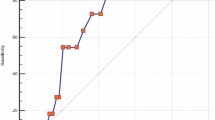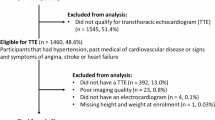Abstract
Little is known about the efficacy of left ventricular hypertrophy diagnosed by electrocardiography for predicting cardiovascular disease in a general Japanese population. In a large cohort of participants selected randomly from the overall Japanese population, we attempted to evaluate the usefulness of a high amplitude R-wave (left high R-wave) on the electrocardiogram for predicting cardiovascular death. A total of 6,688 Japanese (mean age, 50.7 years old; 57% women) free of previous cardiovascular disease and use of antihypertensive agents at baseline were followed for 10 years, from 1990 to 2000. Left high R-wave on the electrocardiogram (the Minnesota Code, 3-1 or 3-3) was found in 9.4% of the 6,688 participants, in 14.6% of the 2,413 hypertensives and in 4.1% of the 4,275 normotensives. During the follow-up period, 128 participants died due to cardiovascular disease. After adjustment for systolic blood pressure and other risk factors, left high R-wave conferred an increased risk of cardiovascular death; the hazard ratio among all the participants was 1.88 (95% confidence interval, 1.22–2.89; p<0.01), that among hypertensives was 1.97 (1.20–3.24; p=0.01), and that among normotensives was 1.66 (0.69–3.98; p=0.26). The population attributable risk percent of left high R-wave for cardiovascular death was 7.6% among all participants, 12.4% among hypertensives and 4.1% among normotensives. Left high R-wave on electrocardiogram, irrespective of the level of systolic blood pressure, was a predictive marker for cardiovascular death among community-dwelling Japanese.
Similar content being viewed by others
Article PDF
References
Panidis IP, Kotler MN, Ren JF, Mintz GS, Ross J, Kalman P : Development and regression of left ventricular hypertrophy. J Am Coll Cardiol 1984; 3: 1309–1320.
Okin PM, Devereux RB, Jern S, et al, LIFE Study Investigators : Regression of electrocardiographic left ventricular hypertrophy during antihypertensive treatment and the prediction of major cardiovascular events. JAMA 2004; 292: 2343–2349.
Nippon Data 80 Research Group: Impact of elevated blood pressure on mortality from all causes, cardiovascular diseases, heart disease and stroke among Japanese: 14 year follow-up of randomly selected population from Japanese—Nippon Data 80. J Hum Hypertens 2003; 17: 851–857.
Ohkubo T, Kikuya M, Metoki H, et al: Prognosis of “masked” hypertension and “white-coat” hypertension detected by 24-h ambulatory blood pressure monitoring 10-year follow-up from the Ohasama study. J Am Coll Cardiol 2005; 46: 508–515.
Hozawa A, Ohkubo T, Kikuya M, et al: Blood pressure control assessed by home, ambulatory and conventional blood pressure measurements in the Japanese general population: the Ohasama study. Hypertens Res 2002; 25: 57–63.
Kawabe H, Saito I, Saruta T : Status of home blood pressure measured in morning and evening: evaluation in normotensives and hypertensives in Japanese urban population. Hypertens Res 2005; 28: 491–498.
Tanaka H, Iso H, Yokoyama T, Yoshiike N, Kokubo Y : Major health problems (cerebrovascular disease), in Detels R, McEwen J, Beaglehole R, Tanaka H ( eds): Oxford Textbook of Public Health, 4th ed, Vol 3. Oxford, Oxford University Press, 2001, pp 1193–1226.
Omae T, Oita J, Ueda K : The Japanese experience in hemorrhagic stroke. J Hypertens 1994; 12 ( Suppl 10): S19–S23.
Kita Y, Okayama A, Ueshima H, et al: Stroke incidence and case fatality in Shiga, Japan 1989–1993. Int J Epidemiol 1999; 28: 1059–1065.
Shimamoto T, Iso H, Iida M, Komachi Y : Epidemiology of cerebrovascular disease: stroke epidemic in Japan. J Epidemiol 1996; 6 ( Suppl): S43–S47.
Ueshima H, Okayama A, Kita Y, Choudhury SR : Current epidemiology of hypertension in Japan. Nippon Rinsho 1997; 55: 2028–2033 ( in Japanese).
Kannel WB, Gordon T, Offutt D : Left ventricular hypertrophy by electrocardiogram. Prevalence, incidence, and mortality in the Framingham study. Ann Intern Med 1969; 71: 89–105.
Kannel WB : Left ventricular hypertrophy as a risk factor: the Framingham experience. J Hypertens 1991; 9 ( Suppl 2): S3–S9.
Larsen CT, Dahlin J, Blackburn H, et al: Prevalence and prognosis of electrocardiographic left ventricular hypertrophy, ST segment depression and negative T-wave; the Copenhagen City Heart Study. Eur Heart J 2002; 23: 315–324.
Okamura T, Kadowaki T, Hayakawa T, Kita Y, Okayama A, Ueshima H : What cause of mortality can we predict by cholesterol screening in the Japanese general population? J Intern Med 2003; 253: 169–180.
Okamura T, Hayakawa T, Kadowaki T, et al: Resting heart rate and cause-specific death in a 16.5-year cohort study of the Japanese general population. Am Heart J 2004; 147: 1024–1032.
Ueshima H, Choudhury SR, Okayama A, et al: Cigarette smoking as a risk factor for stroke death in Japan. NIPPON DATA80. Stroke 2004; 35: 1836–1841.
Okamura T, Hayakawa T, Kadowaki T, Kita Y, Okayama A, Ueshima H, The NIPPON DATA90 Research Group: The inverse relationship between serum high-density lipoprotein cholesterol level and all-cause mortality in a 9.6-year follow-up study in the Japanese general population. Atherosclerosis 2006; 184: 143–150.
Wolf PA, Dawber TR, Thomas HE Jr, Kannel WB : Epidemiologic assessment of chronic atrial fibrillation and risk of stroke: the Framingham study. Neurology 1978; 28: 973–977.
Prineas RJ, Crow RS, Blackburn H : The Minnesota Code Manual of Electrocardiographic Findings: Standards and Procedures for Measurement and Classification. Littleton, John Wright-PSG Inc, 1982.
Nakamura M, Sato S, Shimamoto T : Improvement in Japanese clinical laboratory measurements of total cholesterol and HDL-cholesterol by the US Cholesterol Reference Method Laboratory Network. J Atheroscler Thromb 2003; 10: 145–153.
Wachtell K, Rokkedal J, Bella JN, et al: Effect of electrocardiographic left ventricular hypertrophy on left ventricular systolic function in systemic hypertension (the LIFE Study). Losartan Intervention for Endpoint. Am J Cardiol 2001; 87: 54–60.
Stojanovic MM, O'Brien E, Lyons S, Stanton AV : Silent myocardial ischaemia in treated hypertensives with and without left ventricular hypertrophy. Blood Press Monit 2003; 8: 45–51.
Mansour P, Bostrom PA, Mattiasson I, Lilja B, Berglund G : Low blood pressure levels and signs of myocardial ischaemia: importance of left ventricular hypertrophy. J Hum Hypertens 1993; 7: 13–18.
Novo S, Barbagallo M, Abrignani MG, et al: Increased prevalence of cardiac arrhythmias and transient episodes of myocardial ischemia in hypertensives with left ventricular hypertrophy but without clinical history of coronary heart disease. Am J Hypertens 1997; 10: 843–851.
Cuspidi C, Mancia G, Ambrosioni E, Pessina A, Trimarco B, Zanchetti A, APROS Investigators : Left ventricular and carotid structure in untreated, uncomplicated essential hypertension: results from the Assessment Prognostic Risk Observational Survey (APROS). J Hum Hypertens 2004; 18: 891–896.
Selvetella G, Notte A, Maffei A, et al: Left ventricular hypertrophy is associated with asymptomatic cerebral damage in hypertensive patients. Stroke 2003; 34: 1766–1770.
Reichek N, Devereux RB : Left ventricular hypertrophy: relationship of anatomic, echocardiographic and electrocardiographic findings. Circulation 1981; 63: 1391–1398.
Author information
Authors and Affiliations
Consortia
Corresponding author
Rights and permissions
About this article
Cite this article
Nakamura, K., Okamura, T., Hayakawa, T. et al. Electrocardiogram Screening for Left High R-Wave Predicts Cardiovascular Death in a Japanese Community-Based Population: NIPPON DATA90. Hypertens Res 29, 353–360 (2006). https://doi.org/10.1291/hypres.29.353
Received:
Accepted:
Issue date:
DOI: https://doi.org/10.1291/hypres.29.353
Keywords
This article is cited by
-
The Japanese Society of Hypertension Guidelines for the Management of Hypertension (JSH 2019)
Hypertension Research (2019)
-
Antidiabetic activity of mefloquine via GLP-1 receptor modulation against STZ–NA-induced diabetes in albino wistar rats
3 Biotech (2018)
-
Prognostic value of highly sensitive troponin T on cardiac events in patients with chronic kidney disease not on dialysis
Heart and Vessels (2013)
-
Electrocardiographic changes with the onset of diabetes and the impact of aerobic exercise training in the Zucker Diabetic Fatty (ZDF) rat
Cardiovascular Diabetology (2010)
-
The proportion of individuals with obesity-induced hypertension among total hypertensives in a general Japanese population: NIPPON DATA80, 90
European Journal of Epidemiology (2007)



